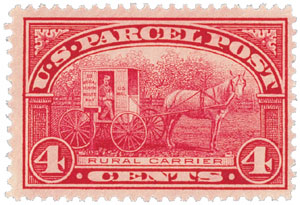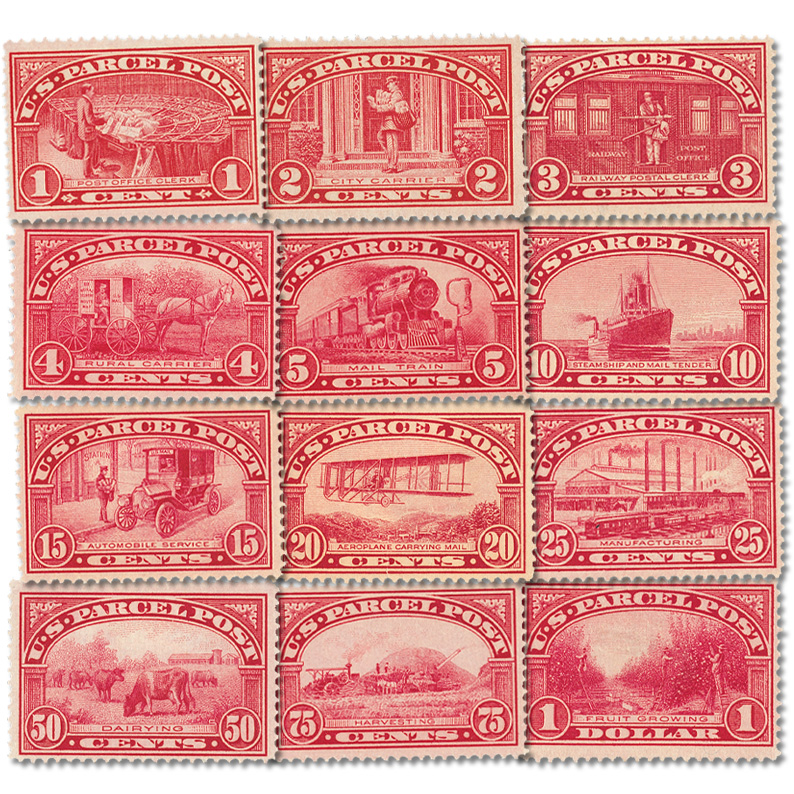
# JQ1-5 - 1913 1c-25c Parcel Post Postage Due Stamps, 5 stamps
Save on the Complete Parcel Postage Due Set
Get the entire set of five Parcel Postage Due stamps and save off Mystic’s regular retail prices. It’s a convenient, money-saving way to add this important stamp history to your U.S. stamp collection!
For a mere six months in 1913, Parcel Postage Due stamps were required by law on packages bearing less than the necessary postage.
Before 1912, private companies controlled package deliveries throughout the U.S. Small towns were often overlooked in favor of more lucrative cities.
Effective January 1, 1913, the U.S. Post Office offered parcel delivery. Parcel Postage Due stamps paid the makeup fee for underpaid packages. At the end of six months, the Parcel Posts were replaced with ordinary postage stamps.
Parents Mail Their Daughter

On February 19, 1914, parents in Idaho took advantage of the affordable Parcel Post rate to mail their daughter to her grandmother’s house.
A year earlier, the Post Office Department had initiated its Parcel Post service for fourth-class mail on January 1, 1913. Parcel Post service could be used for sending items weighing 16 ounces or more through the mail. The mail is divided into four classes, with Parcel Post making up the fourth class. Almost any type of merchandise could be mailed parcel post, including day-old chicks, baby alligators, and honeybees. Only items that could be dangerous to handle could not be sent through Parcel Post.

It wasn’t long after the new service began that parents found an interesting loophole. None of the regulations concerning parcel post prohibited the mailing of people, and other living beings were being mailed that way. In January 1913, Mr. and Mrs. Jesse Beauge of Glen Este, Ohio, sent their young son via Rural Free Delivery one mile to his grandmother’s. The parents paid 15¢ for the stamps and insured their son for $50. Later that month, a family in Pine Hollow, Pennsylvania mailed their daughter to relatives in Clay Hollow at a cost of 45¢.

Then on February 19, 1914, five-year-old May Pierstorff’s parents in Grangeville, Idaho, wanted to send their daughter to visit her grandparents 73 miles away. They placed 53¢ in stamps on her coat and handed her over to the postal worker on the Railway mail train, who also happened to be a relative. Despite her safe delivery to her grandmother’s doorstep, once Postmaster General Albert S. Burleson heard her story, he officially prohibited postal workers from accepting humans to be mailed.

In spite of this, a woman mailed her six-year-old daughter 720 miles from Florida to Virginia the following year for 15¢. The last known instance of a child being mailed came in August 1915, when three-year-old Maud Smith was mailed from her grandparents to her sick mother in Kentucky. Even after this, some people attempted to mail children, but postmasters rejected their applications claiming they couldn’t be classified as “harmless live animals.”

Click here to pick out the individual Parcel Post and Parcel Post Postage Due stamps you need.
Save on the Complete Parcel Postage Due Set
Get the entire set of five Parcel Postage Due stamps and save off Mystic’s regular retail prices. It’s a convenient, money-saving way to add this important stamp history to your U.S. stamp collection!
For a mere six months in 1913, Parcel Postage Due stamps were required by law on packages bearing less than the necessary postage.
Before 1912, private companies controlled package deliveries throughout the U.S. Small towns were often overlooked in favor of more lucrative cities.
Effective January 1, 1913, the U.S. Post Office offered parcel delivery. Parcel Postage Due stamps paid the makeup fee for underpaid packages. At the end of six months, the Parcel Posts were replaced with ordinary postage stamps.
Parents Mail Their Daughter

On February 19, 1914, parents in Idaho took advantage of the affordable Parcel Post rate to mail their daughter to her grandmother’s house.
A year earlier, the Post Office Department had initiated its Parcel Post service for fourth-class mail on January 1, 1913. Parcel Post service could be used for sending items weighing 16 ounces or more through the mail. The mail is divided into four classes, with Parcel Post making up the fourth class. Almost any type of merchandise could be mailed parcel post, including day-old chicks, baby alligators, and honeybees. Only items that could be dangerous to handle could not be sent through Parcel Post.

It wasn’t long after the new service began that parents found an interesting loophole. None of the regulations concerning parcel post prohibited the mailing of people, and other living beings were being mailed that way. In January 1913, Mr. and Mrs. Jesse Beauge of Glen Este, Ohio, sent their young son via Rural Free Delivery one mile to his grandmother’s. The parents paid 15¢ for the stamps and insured their son for $50. Later that month, a family in Pine Hollow, Pennsylvania mailed their daughter to relatives in Clay Hollow at a cost of 45¢.

Then on February 19, 1914, five-year-old May Pierstorff’s parents in Grangeville, Idaho, wanted to send their daughter to visit her grandparents 73 miles away. They placed 53¢ in stamps on her coat and handed her over to the postal worker on the Railway mail train, who also happened to be a relative. Despite her safe delivery to her grandmother’s doorstep, once Postmaster General Albert S. Burleson heard her story, he officially prohibited postal workers from accepting humans to be mailed.

In spite of this, a woman mailed her six-year-old daughter 720 miles from Florida to Virginia the following year for 15¢. The last known instance of a child being mailed came in August 1915, when three-year-old Maud Smith was mailed from her grandparents to her sick mother in Kentucky. Even after this, some people attempted to mail children, but postmasters rejected their applications claiming they couldn’t be classified as “harmless live animals.”

Click here to pick out the individual Parcel Post and Parcel Post Postage Due stamps you need.














